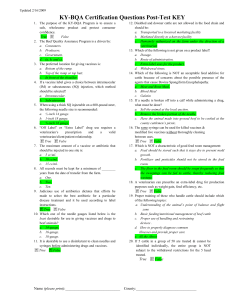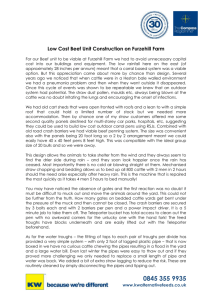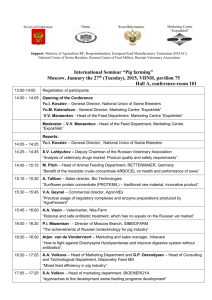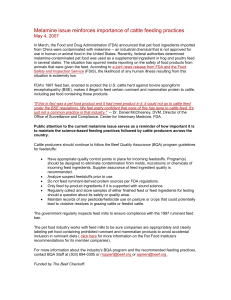Name
advertisement
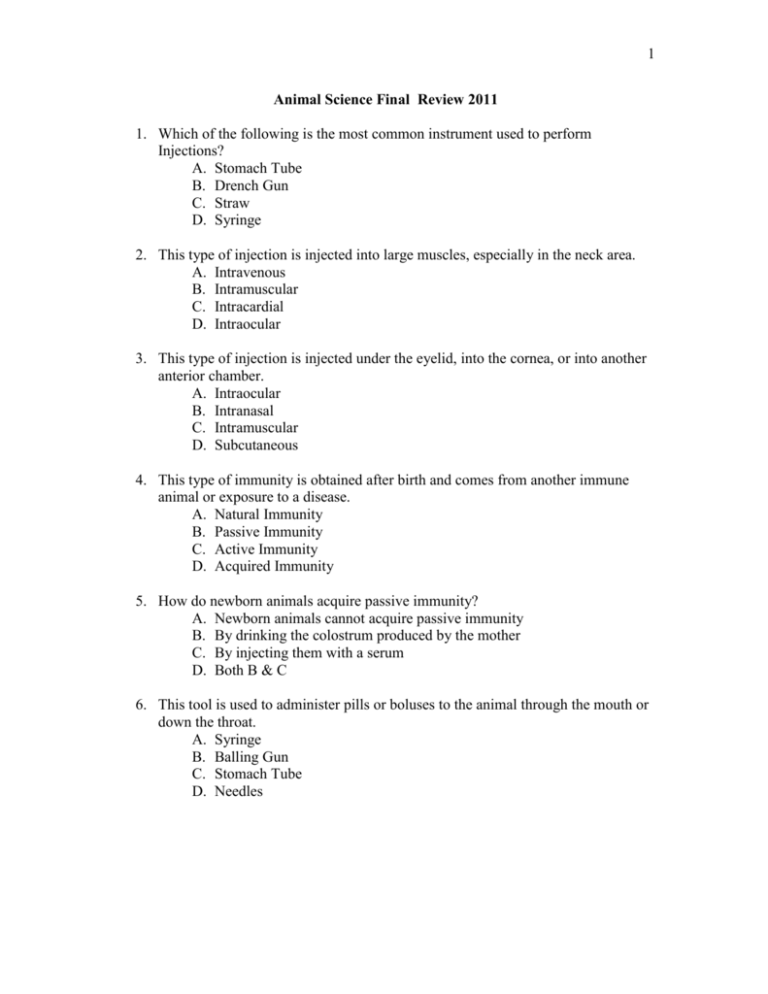
1 Animal Science Final Review 2011 1. Which of the following is the most common instrument used to perform Injections? A. Stomach Tube B. Drench Gun C. Straw D. Syringe 2. This type of injection is injected into large muscles, especially in the neck area. A. Intravenous B. Intramuscular C. Intracardial D. Intraocular 3. This type of injection is injected under the eyelid, into the cornea, or into another anterior chamber. A. Intraocular B. Intranasal C. Intramuscular D. Subcutaneous 4. This type of immunity is obtained after birth and comes from another immune animal or exposure to a disease. A. Natural Immunity B. Passive Immunity C. Active Immunity D. Acquired Immunity 5. How do newborn animals acquire passive immunity? A. Newborn animals cannot acquire passive immunity B. By drinking the colostrum produced by the mother C. By injecting them with a serum D. Both B & C 6. This tool is used to administer pills or boluses to the animal through the mouth or down the throat. A. Syringe B. Balling Gun C. Stomach Tube D. Needles 2 7. Which of the following is NOT a benefit of proper livestock identification? A. Ownership Purposes B. Disease Prevention C. Food Safety D. Artificial Insemination 8. Which of the following is a common identification method for poultry? A. Leg Band B. Hot Iron Brand C. Freeze Brand D. Ear Notch 9. When identifying cattle, the method which uses ink to take an image of the animals nose is called: A. Finger Printing B. Ink Printing C. Nose Printing D. Nose Tattoo 10. When freeze branding, what is sprayed on the animal in order to clean the designated branding area? A. Liquid Nitrogen B. Water C. Hair Spray D. 99% Alcohol 11. Which of the following is NOT a common identification method for swine? A. Leg band B. Ear Notch C. Tattoo D. Ear tag 12. At what age should swine be ear notched, if possible? A. 1-3 Days of age B. 1-3 Weeks of age C. 1-3 Months of age D. 1-3 Years of age 13. When ear notching swine, how far apart should you leave between each notch? A. 2 inches B. 1/16 inch C. 1 inch D. ¼ inch 3 14. Which of the following is NOT a safety procedure mentioned in class for ear notching swine? A. Keep equipment clean. B. Keep all freshly ear notched pigs confined in one pen together. C. Avoid making notches too close to the head. D. Store tools in a clean, dry area. 15. An animal grazing more heavily when near a water source is an example of what type of behavior? A. Social Behavior B. Maternal Behavior C. Investigative Behavior D. Feeding Behavior 16. Distress and mating calls would be considered which type of behavior? A. Communicative Behavior B. Social Behavior C. Fear Behaviors D. Feeding Behaviors 17. What is the term for the study of animal behavior in the animal’s natural habitat? A. Animal science B. Ethology C. Reality D. Habituation 18. Which of the following is NOT an example of a social behavior? A. Fighting B. Social Ranks C. Standing Heat D. All of the above are examples of social behaviors 19. Increased temperature can be caused by infection. A. True B. False 20. Which of the following is a common cause of stress in animals? A. Fatigue B. Transportation C. Overcrowding D. All of the above 4 21. The act of exposing animals to humans in order to decrease stress on the animals during their future contacts with people is called: A. Imprinting B. Impacting C. Relating D. Communicating 22. Which of the following is NOT one of the six classes of nutrients? A. Water B. Protein C. Sugars D. Vitamins 23. This type of protein can come directly or indirectly from plants. A. Animal Protein B. Good Protein C. Bad Protein D. Plant Protein 24. Which type of mineral is required in larger quantities and must be supplemented in the feed? A. Macro minerals B. Micro minerals (Trace minerals) C. Low quality minerals D. High quality minerals 25. Which nutrient is considered to make up the largest component of our bodies? A. Carbohydrates B. Protein C. Water D. Minerals 26. At room temperature, fats are _________ and oils are _________. A. liquid; solid B. hot; cold C. cold; hot D. solid; liquid 27. Which type of vitamin can be deadly if given in large doses? A. Fat-soluble vitamins B. Water-soluble vitamins C. Oil-soluble vitamins D. All vitamins 5 28. An animal with only one stomach is referred to as a: A. Ruminant B. Monogastric C. Cow D. Horse 29. Which of the following is needed when designing a ranch? A. Land B. Animals C. Equipment D. All of the above 30. When selecting feeds, the producer must consider all of the following EXCEPT: A. Species of animal B. Function of animal C. How much the feed bag weighs D. Availability and cost of feed 31. Food for animals is: A. Food B. Ration C. Snacks D. Feed 32. The injection of semen from a male into the vagina of a female by a chosen tool is called: A. Natural Reproduction B. Artificial Insemination C. Embryo Transfer D. Infertility 33. What does E.P.D. stand for? A. Expected Pedigree Diagram B. Equine Program Diagram C. Expected Progeny Differences D. Equine Progeny Differences 34. What chemical is commonly used as a semen extender? A. Liquid Nitrogen B. Water C. Glucose D. Glycerol 6 35. Which way is the preferred method to store semen? A. Liquid Nitrogen B. Dry ice and alcohol C. In the refrigerator D. Styrofoam cooler 36. Which of the following hormones can be injected into a female in order for ovulation management, (to cause her to come into heat)? A. Prostaglandin B. GnRH C. Oxytocin D. Both A & B 37. Which of the following animals is a ruminant? A. Cow B. Sheep C. Horse D. Both A & B 38. Anemia is an example of what type of disease? A. Viral B. Fungal C. Nutritional D. Bacterial 39. Foot Rot is an example of what type of disease? A. Viral B. Fungal C. Bacterial D. Protozoan 40. How long should you isolate new members of your herd, in order to prevent disease? A. 3 to 4 days B. 3 to 4 hours C. 3 to 4 weeks D. 3 to 4 months 41. Which of the following is an example of a protozoan disease? A. Coccidiosis B. Anthrax C. Warts D. Black Leg 7 42. Which of the following is a common cause of disease in livestock? A. Poor sanitation B. Poor management C. Introduction of new animals to the herd D. All of the above 43. Which of the following is NOT an example of a viral disease? A. Foot Rot B. Cholera C. Newcastle D. Warts 44. Which of the following is a common factor determining behavior in livestock? A. Genetics/Instincts B. Too much sugar C. Environment D. Both A & C 45. Which livestock behavior is a survival emotion that motivates animals to flee from danger? A. Investigative B. Shelter-Seeking C. Fear D. Social 46. All of the following are considered to be fat-soluble vitamins EXCEPT: A. Vitamin A B. Vitamin B12 C. Vitamin D D. Vitamin E 47. The tool used for ear notching swine is called: A. Notchers B. Scissors C. Syringe D. Branding Iron 48. Which nutrient is the major source of energy for animals? A. Protein B. Minerals C. Water D. Carbohydrates 8 49. Which of the following is NOT a tool needed for freeze branding? A. Styrofoam Cooler B. Branding Iron C. Gloves D. Syringe 50. When freeze branding, which animal would require the longest branding time? A. Cow B. Horse C. Calf D. Colt 51. The bony tissues that form the framework of an animal’s body are collectively called? a. Skeletal System c. Respiratory System b. Circulatory System d. Muscular System 52. What type of immunity is the protection one has from birth? a. Acquired b. Natural 53. This instrument is used to give pills or boluses to animals through the mouth and down the throat. a. Dose Syringe c. Balling gun b. Stomach tube d. Drench gun 54. An injection just under the skin is called? a. Intra-muscular c. Subcutaneous b. Intra-dermal d. Intra-cardial 55. Injection made deeply into a large muscle. a. Intra-muscular c. Subcutaneous b. Intra-peritoneal d. Cutaneous 56. One reason for dehorning cattle is less chance of livestock handlers to get injured? a. True b False 57. What is the number one thing to consider when dehorning cattle? a. Weather c. Size of horn b. Type of herd d. Sex 58. To clean dehorning instruments they should be soaked in a disinfecting solution? a. True b. False 9 59. When chemically dehorning cattle the first thing you do is ______________. a. the handler clips a circular band of hair near the base of the small, undeveloped horn or buttons b. the handler applies a ½ inch band of petrolatum or petrolatum jelly to the hair c. the handler wraps paper around one end of the stick and holds the stick by the paper. 60. You should always clean the instruments for mechanical dehorning before and after you use them but only worry about disinfecting it before they are used. a. True b. False 61. Four ounces of cresol per one gallon of water is a good ____________ solution. a. disinfecting b. pain numbing c. blood clotting 62. Hot Iron dehorners are _______________________. a. Bloody b. Bloodless 63. Docking, the shortening of the tail of a young lamb, is a common practice with sheep producers. a. True b. False 64. When is a lamb’s tail usually docked? a. when they are born b. four days to two weeks of age c. 3 mouths of age 65. A _____________________ iron has a preformed letter or number on the end. a. running iron b. stamping 66. Which is an advantage to hot branding? a. it is permanent b. damage to the skin is undesirable to the tanning industry c. hair over the brands must be clipped in the winter to allow clear identification 67. Management is defined as the activities relating to the organization and operation of a firm for the attainment of a specific goals. a. True b. False 10 68. What is the recommended sire to dam ration for a breeding beef operation? a. 1 to 12 b. 1 to 15 c. 1 to 25 69. Which of the following is not a sign of a sick animal? a. Good appetite b. abnormal Weight c. Humped appearance 70. The litter number of swine is always marked on a pig’s ________ear. a. right b. left 71. Intravenous injections are commonly made into the _______vein. a. Right leg b. Lungs c. Jugular 72. Which biological products are used to produce immunity in animals? a. Vaccines b. Bacteria c. Serums d. All of the above 73. Sheep should not be placed on their backs when they are restrained? a. True b. False 74. Which of the following is not an instrument used in surgical castration. a. Emasculator b. Pocket knife c. Burdizzo 75. A castrated calf is called a? a. Bull b. Boar 76. A gestation period is the length of time from: a. Insemination to birth b. Insemination to fertilization c. Conception to birth d. Birth to one year of age c. Steer d. Heifer 11 77. Artificial insemination is the primary breeding method used with a. Turkeys c. Pigs b. Dairy cows d. All of the above 78. What should newborn mammals consume immediately after birth? a. Water c. Feed b. Colosturm d. Both a and b 79. The process of giving birth to an animal is called? a. Gestation c. Parturition b. Conception d. Fertilizaation 80. Bos indicus cattle are characterized by: a. Long ears c. Excessive dewlap b. A humped-neck d. All of the above 81. Cattle have a : a. Single-compartment stomach b. Two-compartment stomach c. Three-compartment stomach d. Four compartment stomach 82. Cattle from feed yards are taken to a processing plant when they reach an average weight of: a. 1100-1200 lbs b. 1200-1300 lbs c. 700-800 lbs d. 800-900 lbs 83. A female horse, at least four years of age is called: a. Colt c. Mare b. Gelding d. Filly 84. Mohair comes from the: a. Kashmir goat b. Angora goat c. Boer goat d. Nubian goat 85. A castrated male goat is called: a. Buck c. Kid b. Ram d. Wether 86. Lanolin is produced from which part of the sheep? a. Fat from by-products c. The skin b. The wool d. Hooves 12 87. The average litter size fro swine is: a. 1-3 piglets c. 2-5 piglets b. 5-8 piglets d. 9-12 piglets 88. What is the term used when a sow or gilt gives birth to a litter of piglets? a. Farrowing c. Birthing b. Calving d. Foaling 89. A hog’s internal organs closely resemble those of a: a. Human c. Goat b. Sheet d. Horse 90. Hogs are taken to the processing plant when they reach: a. 3-4 months of age c. 4-6 months of age b. 8 months d. 1 year of age 91. Poultry refer to bird species such as: a. Chickens c. Turkeys b. Ducks and geese d. All of the above 92. A female chicken that lays eggs is a: c. Pullet c. Hen d. Rooster d. Capon 93. The primary by-product from chickens is: a. Blood c. Bones b. Variety meats d. Feathers 94. At a feed yard pens are cleaned: a. Every day c. At the beginning of each month b. After the cattle are processed d. Between each set of cattle 95. The manure scrapped out of the pens is: a. Sold to area greenhouses pens new pens b. Applied to farm crops as fertilizer heaters c. Used as foundation for d. burned in the barn 96. On average, cattle remain in the feed yard for: a. 60-90 days c. 120-150 days b. 170-200 days d. 365 days 13 97. Normal temperature for cattle is: a. 87.4 F c. 98.6 F b. 101.5 F d. 88.9 F 98. The batch mixer at a feed mill produces how many pounds of feed at one time? a. 1,000 pounds c. 3,000 pounds b. 6, 000 pounds d. 10,000 pounds 99. Corn is harvested when it reaches the ideal moisture percentage of: a. 12 percent c. 20 percent b. 41 percent d. 68 percent 100. The most perfect food is considered: a. Meat c. Eggs b. Milk d. Liver 101. Cows usually chew their cud for three to four hours a day. a. True b. False 102. The period of time that a cow is producing milk is called? a. Parturition b. Lactation b. Regurgitation d. Gestation 103. The leading dairy state is? a. Texas c. Texas b. California d. Wisconsin 104. The udder has eight teats. a. True b. False 105. There is an estimated ______million dairy cattle in the United States? a. 10 million c. 5 million b. 15 million d. 12 million 106. Water is needed in the regulation of body temperature. a. True b. False 107. Nutrients are either essential or nonessential. a. True b. False 14 108. Which of the following is not a class of nutrients? a. Proteins c. Water b. Carbohydrates d. Calcium 109. The heart is responsible for pumping blood to all body parts. a. True b. False 110. Abdominal pains, vomiting, diarrhea sometimes with blood in it is a symptom of: a. Brucellosis b. Pneumonia b. Ecoli d. Tetanus 111 Causes abortions in all species and may permanently reduce fertility in a herd a. Brucellosis b. Tetanus b. Lockjaw d. Warts 112. Extreme sensitivity to bright lights, sounds, or touch, usually contracted by an animal bite. Old Yeller. a. Tetanus c. Brucellosis b. Rabies d. Warts 113. Headache, fever, muscle aches, loss of appetite, swollen glands, stiff neck, vomiting, skin rash, caused by mosquitoes. a. West Nile c. Tetanus b. Rabies d. Warts 114. Finish refers to the amount of fat produced by market animals. a. True b. False 115. A ration that supports growth prevents any loss or gain of tissue in an animal’s body when no production occurs is a finishing ration. a. True b. False 116. Anthelmintics should be administered to livestock on a monthly basis. a. True b. False 117 . A feed additive is considered to be an antibiotic if it enhances the growth of bacteria. a. True b. False 118. . MGA is a hormone used as a feed additive to suppress estrus in females. a. True b. False 15 119. Buffers resist changes in the pH of the rumen when acids are present. a. True b. False 120. The FDA conducts test to see if feed additives contain cancercausing agents. b. True b. False 121. To control the problem of bloat n non-ruminants, poloxaline is added to the feed. a. True b. False 122. The TBA regulates the use of additives. a. True b. False 123. Functions of antibiotics are to limit the growth of bacteria in an animal’s body. a. True b. False 124. Which is not included as major information on the feed tag or label. a. Net weight c. Brand name b. Analysis of feed d. Color of feed 125. Water content in a feed sample is determined by the weighing of a wet sample. a. True b. False 126. A chemical analysis determining the crude protein content of a feedstuff also determines the nitrogen content of the sample. a. True b. False 127. Crude fat is often referred to as ether content. a. True b. False 128. Palatability refers to how well an animal likes the feed. a. True b. False 129. Lush legume pastures can be a source of digestive disturbances in livestock which may cause a bloating condition. a. True b. False 130. The FDA publishes a pamphlet about official information about approval of antibiotics and other animal drugs. a. True b. False 16 131. A collection of pus contained in an inflamed tissue. a. Sore c. Abscess b. Pinch point d. Blemish 132. What percent of water is in milk? a. 87% c. 15% b. 25% d. 12% 133. Oldest and purest dairy cattle, came from Switzerland. a. Holstein c. Brown Swiss b. Jersey d. Aryshire 134. Distended abdomen, violent rolling or kicking is a symptom of: a. Rabies c. Flu b. Colic d. Pneumonia 135. Ranks # 1 in the world for pork production. a. United States c. California b. China d. Alaska 136. White hog, droopy ears, small bluish freckles, very prolific. a. Chester White c. Yorkshire b. Hampshire d. Duroc 137. Which of the following hog does not have erect ears? a. Hampshire c. Yorkshire b. Berkshire d. Duroc 138. Black hog six white feet, face and legs, erect ears. a. Poland China c. Hampshire b. Berkshire d. Landrace 139. Which is not a primal part of the hog carcass? a. Ham c. Loin b. Belly d. Hocks 140. Originated in India and Brazil, humped cattle, heat tolerant, slick skin. a. Brangus c. Hereford b. Brahman d. Limousine 141. Originated on the King Ranch, maternal, cherry red in color, developed for the rough, rugged terrain of South Texas. a. Brahman c. Hereford b. Limousine d. Santa Gertrudis 17 142. Exotic breed, light straw in color, originated in France, very heavily muscled. a. Brahman c. Hereford b. Charolais d. Santa Gertrudis 143. Medium to dark red in color, originated in England, white underline, switch, crest, face and legs. a. Brangus c. Hereford b. Limousine d. Santa Gertrudis 144. Which of the following is not a leading dairy producing state? a. California c. Wisconsin b. Texas d. New York 145. A disease prevents or impairs an animal’s function and is harmful to the surroundings. a. True b. False 146. If an animal’s ration is not balanced their resistance to disease is lowered. a. True b. False 147. Morphological defects are such as cuts and bruises, broken bones, scratches and scrapes. a. True b. False 148. Bacteria can be seen with the naked eye. a. True b. False 149. Iron deficiency, lack of red blood cells is a symptom of: a. Colic c. Rabies b. Anemia d. Bloat 150. Sheep and goats have a tendency to over eat and this can be deadly to them. a. True b. False


